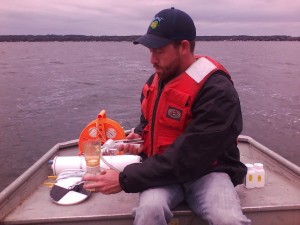
A number of ongoing activities are preformed regularly to insure the protection and health of Big Green Lake. These activities include, but are not limited to: measuring phosphorus and suspended sediment levels in and around the lake, monitoring the clarity of the water at various stations around the lake, bacteria sampling at the lake beaches and lake tributaries, and various other water sampling and temperature tracking.
Lake & Watershed Monitoring
The GLSD is committed to an extensive Lake & Watershed Monitoring Program in partnership with the USGS. This contract involves an annual cost to the GLSD and USGS of just under $100,000. The lake and tributary monitoring involves appropriate nutrient measurements (i.e. Phosphorus) as well as other important water quality information. This monitoring is vitally important to the ongoing health, maintenance and protection of the lake and watershed. The monitoring data and information allow all users to track the status of the resources as well as the impact of the ongoing implementation of the Lake Management Plan (LMP).
Beach Coliform Bacteria Sampling
The primary tool used at present to evaluate beach water quality is the measurement of “indicator” organisms that estimate the level of fecal contamination of the water. The indicator organisms most commonly used are fecal coliforms, Escherichia coli (E. coli), and enterococci. These coliform bacteria are microorganisms that usually occur in the intestinal tract of animals, including humans. High levels of these organisms in recreational water are indicative of fecal contamination and the possible presence of intestinal-disease-causing organisms.
Federal and State recreational water quality guidelines recommend bacterial levels below which the risk of human illness is considered to be minimal. For public beaches, the regional Health Departments generally monitor beach water quality. [The Green Lake Sanitary District monitors local Green Lake beach waters.] When contaminant indicator levels in the bathing beach water reach levels that are considered to pose a risk to health, public beaches may be posted with a sign warning bathers of these potential health risks.
The Wisconsin Beach Monitoring Program was developed in accordance with EPA performance criteria for the following: 1) Sampling and monitoring, 2) promptly notifying the public of exceedances of the water quality standard for E. coli, and 3) reporting.